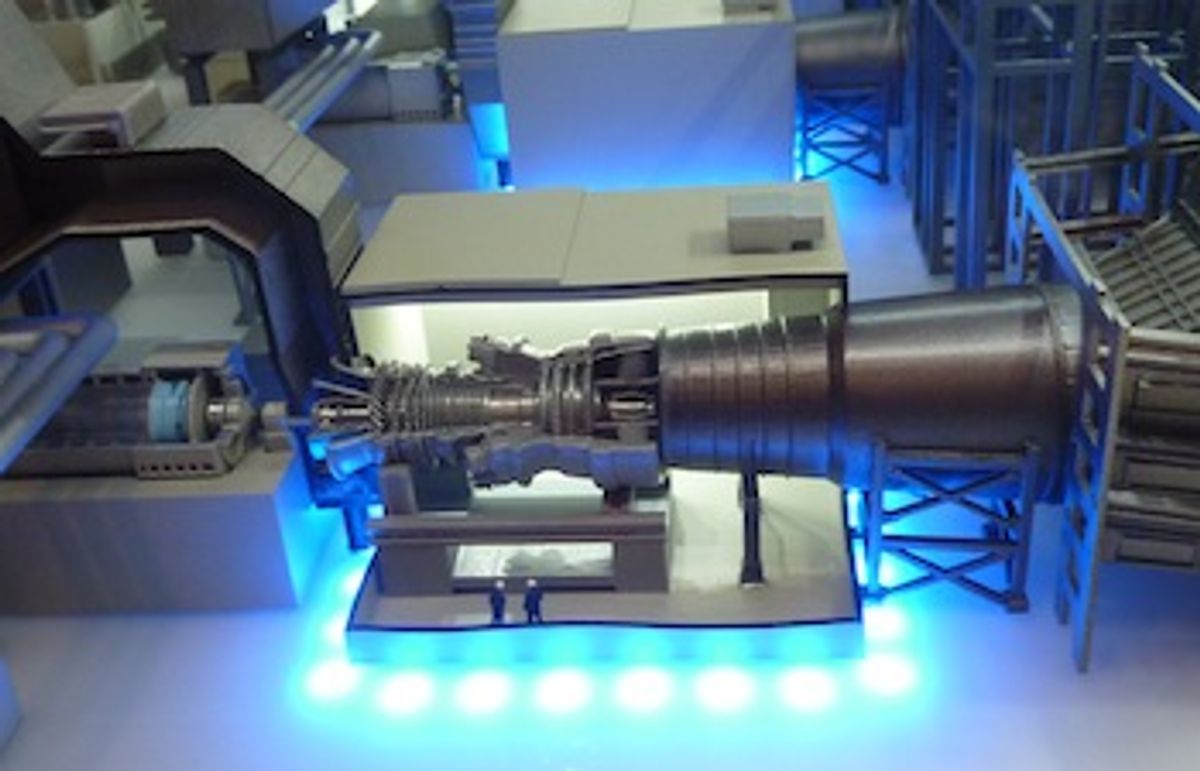Last week General Electric launched a set of 60 Hz gas turbines, intended for use in the U.S., Japan, Saudi Arabia, and elsewhere, complementing a group of 50 Hz gas turbines introduced last year for use in Europe, much of Asia, and Africa. Together, these FlexEfficiency turbines represent a new generation of gas turbine technology, the first totally new design since the late 80s, said Eric Gebhardt, vice president of thermal engineering for GE Energy.
And what a difference a couple of decades makes.
The FlexEfficiency turbines will be able to rapidly increase or decrease power output. This is important when gas generation facilities are combined with renewables like wind and solar. Gas turbines designed in the 80s, explained Gebhardt, were optimized for efficiency, overall availability, and reliability; not for how fast they start up or shut down. And fast startups and shutdowns are tricky, he explained, because of the changes and stresses different parts of the turbine go through in response to the dramatic changes in temperature. The new turbines are incorporating better materials for thermal management, he said, including nickel-based superalloys and single-crystal materials along the hot gas path. They also use better cooling systems, integrate a better understanding of the clearances involved when different parts expand and contract at different rates, and rely on physics-based models for combustion control. As a result of the new design, Gebhardt said, a 750 megawatt system can reduce its power output to about 100 megawatts in about 6 and a half minutes and come back up again just as fast; previous facilities could only dial back to about 200 megawatts without fully shutting down and took several minutes longer to come back up.
Alex Trembath, a policy analyst for the Breakthrough Institute, told power company executives and journalists at a launch event in San Francisco, Calif., last Wednesday that initially people thought that the availability of cheap natural gas would be a threat to renewable energy, however, he said, it can be a boon. Gas turbines that can come online quickly when the sun doesn’t shine or the wind doesn’t blow make solar and wind power a more realistic option for utilities focused on providing continuous power.
Celal Metin, chairman and CEO of the MET Group of Companies, Istanbul, Turkey, told the group that he has a different perspective; he sees solar and wind energy as ways of getting the most out of the use of natural gas; “when we combine these into a total plant concept, we see economics [of gas] are much better.”
When engineers at General Electric started developing this generation of gas turbines about three years ago, they had no idea that new techniques for gas extraction would suddenly make gas a more abundant and cheaper (at least in the U.S.) fuel. Instead, the company focused on creating systems that could increase and reduce power quickly, and therefore coordinate nicely with renewable forms of energy. But recent developments certainly make it a good time to launch technologies for generating power from natural gas; perhaps that’s why GE is calling this launch, with $1.2 billion in preorders at launch date, its most successful ever.
Said Gebardt, three years ago natural gas wasn’t predicted to go to $3 per million BTU, the energy portfolio shifts in Japan away from nuclear weren’t expected, so in hindsight starting this development, wound up, to put it mildly, “being the right decision.”
We picked the right product to build, he said, “and it’s even a better product today.”
The company announced that it will be shipping six new FlexEfficiency turbines to Chubu Electric Co.’s Nishi-Nagoya plant in Nagoya, Japan, where they will replace oil-fired generation equipment; eight to the Saudi Electricity Company in Riyadh, Saudi Arabia, in a brand-new plant; two to the Cherokee Clean Air Clean Jobs Project in Colorado, where they will replace coal-fired equipment; two to the Hess Corp. for a yet to be announced project in the U.S.; and one to another unannounced U.S. customer. The FlexEfficiency turbines will be manufactured and tested in Greenville, S.C.
Follow me on Twitter @TeklaPerry.
Photo: Scale model of GE's FlexEfficiency 60. Credit: Tekla Perry
Tekla S. Perry is a senior editor at IEEE Spectrum. Based in Palo Alto, Calif., she's been covering the people, companies, and technology that make Silicon Valley a special place for more than 40 years. An IEEE member, she holds a bachelor's degree in journalism from Michigan State University.




